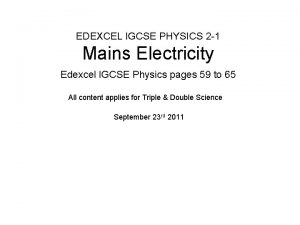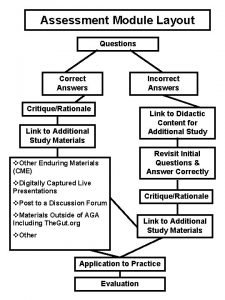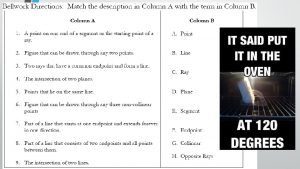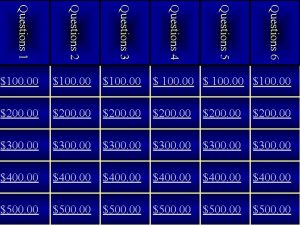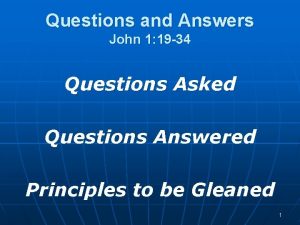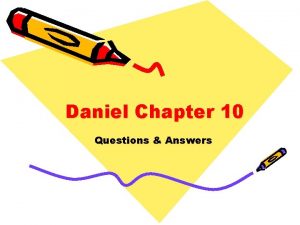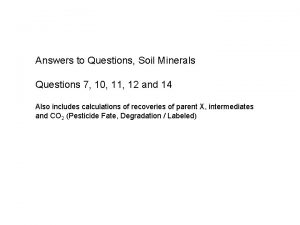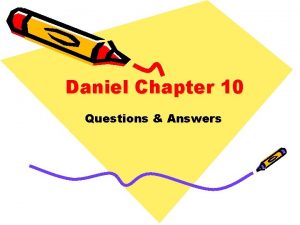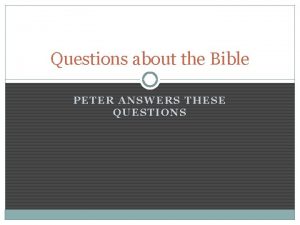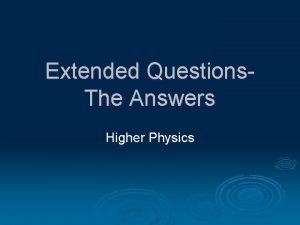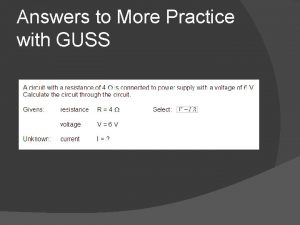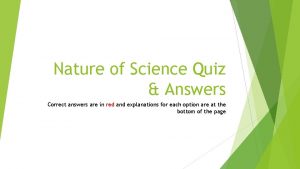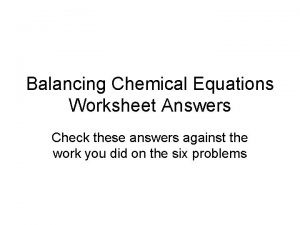What is Physics Physics answers the questions 3




































- Slides: 36

What is Physics? Physics answers the questions 3 year olds ask – WHY? ? Dictionary: “the study of matter, energy, and the interaction between them”

Physics “the study of matter, energy, and the interaction between them” Matter anything that has mass and takes up space or the amount of stuff that makes up an object

Physics “the study of matter, energy, and the interaction between them” Energy - Ability or capacity to do work Work – process of moving an object Energy - Ability or capacity to move an object

Physics “the study of matter, energy, and the interaction between them”

Physics “the study of matter, energy, and the interaction between them” Key concept of course The source of all energy on Earth is the conversion of mass into energy

PHYSICS Most basic of the sciences Study of EVERYTHING § Motion (mechanics) § Fluids § Heat § Sound § Light and Optics § Electricity and Magnetism § Waves and Oscillations § Relativity § Atomic Structure § Nuclear Physics § Elementary Particle Physics § Astrophysics

AP Physics 1 BIG IDEAS 1. Objects and systems have properties such as mass and charge. Systems of objects may have internal structure. 2. The interaction of an object with other objects can be described by forces. 3. Fields existing in space can also be used to explain interactions. 4. Interactions between systems can result in changes of those systems. 5. Changes that occur as a result of interactions are constrained by conservation laws. 6. Waves can transfer energy and momentum from one location to another without the permanent transfer of mass, and serve as a mathematical model for the description of other phenomena.

How is Science Practiced? Ask questions (science) OR define a problem (engineering) Develop or use a model (expected) Plan and carry out an experimental investigation Analyze and interpret data using mathematical and computational techniques Compare experimental results and expected model to construct explanations (science) OR design solutions (engineering) Engage in argument (make conclusions) from evidence Communicate information

Science is NOT just a mechanical process of collecting facts and making theories It is a CREATIVE PROCESS

Theory Theories are never derived directly from observations Theories are inspirations that come from the creativity of the human mind Examples § § § Atomic Theory of Matter Copernicus’ Heliocentric Theory of Relativity Electromagnetic Theory of Light Newtons Law of Universal Gravitation

Math Review

Dimensions and units SI base units Quantity SI unit symbol Length Mass Time Electric current temperature Luminous intensity Amount of substance meter kilogram second ampere kelvin candela mole m kg s A K cd nol All other units can be derived from the 7 base units

Metric Prefixes and Symbols Astronomical 1 000 000 000 = 1018 exa 1 000 000 000 = 1015 peta 1 000 000 = 1012 tera 1 000 000 = 109 giga 1 000 = 106 mega 1 000 = 103 kilo 100 = 102 Hecto 10 = 101 deca 0. 1 = 10 -1 deci 0. 01 = 10 -2 centi 0. 001 = 10 -3 milli 0. 000 001 = 10 -6 micro 0. 000 001 = 10 -9 nano 0. 000 000 001 = 10 -12 pico 0. 000 000 001 = 10 -15 femto 0. 000 000 000 001 = 10 -18 atto Sym E P T G M k h da d c m m n p f a Human prefix Sun (1. 4 x 109 m) Earth (1. 3 x 107 m) Softball (10 -1 m) cells (10 -5 m) proteins Atomic Cellular Quantity Milky Way (1021 m) Subatomic (5 -10 nm) H atom (10 -10 m) Proton (10 -15 m) Electron, quarks

Scientific Notation: Used to express very large or very small numbers. Based on powers of 10 Examples: 20, 000 = 2 x 10, 000 = 2 x (10 x 10) = 2 x 104 497, 100, 000 = 4. 971 x 108 move decimal right 8 times 0. 000000582 = 5. 82 x 10 -7 move decimal left 7 times

Scientific Notation: Try these 5. 3 x 10 -3 = 0. 0053 351000 = 6. 34 x 105 = 634, 000 0. 00000877 = 8. 77 x 10 -6 5. 56 x 107 = 55, 600, 000 3. 51 x 105

Rules for multiplication and division in Scientific Notation: Multiplication 1. Multiply coefficients 2. Add exponents Division 1. divide coefficients 2. subtract exponents

Express in Scientific Notation: (5 x 10 -5)(7 x 1010) = 3. 5 x 106 (5 x 10 -5)(8 x 1010) (4 x 104) = 1. 6 x 1011 1. 6 x 1015 81 x 10 -12

Dimensional Analysis problem-solving method that uses the fact that any number or expression can be multiplied by one without changing its value 1 inch = 2. 54 cm 1 cm = 10 mm How many cm long is a 100 yard football field?

Dimensional Analysis 1 inch = 2. 54 cm 1 cm = 10 mm 5280 ft = 1 mi 1. A fish tank is 20 in x 12 in. What is its volume in mm 3? 4. 7 x 107 mm 3 2. The speed of light is 3 x 108 m/s. What is the speed of light in mph? 6. 7 x 108 mph

Being able to manipulate formulae to solve for a variable is an extremely important skill in Physics. It is done to isolate a single variable to make problem solving easier. The formulae below are a few used during the course. Manipulate the variables algebraically and solve for the variable indicated.

Manipulate the variables algebraically and solve for the variable indicated. a) Isolate m: m = ? b) Isolate f: f = ? c) If the units of m are [kg], the units of v are [m/s], the units of r are [m] and the units of T are [kg m/s 2], what are the units of f?

Algebra Review The following are ordinary physics problems. Place the answer in scientific notation when appropriate and simplify the units.

Right Triangle Trigonometry Using the generic triangle to SOHCAHTOA the right, Right Triangle Trigonometry and Pythagorean Theorem solve the following. Your calculator must be in degree mode. a) q=55 o and c=32 m. Solve for a and b b) a=250 m and b=180 m. Solve for θ and c.

Experimental Design

How is Science Practiced? Ask questions (science) OR define a problem (engineering) Develop or use a model (expected) Plan and carry out an experimental investigation Analyze and interpret data using mathematical and computational techniques Compare experimental results and expected model to construct explanations (science) OR design solutions (engineering) Engage in argument (make conclusions) from evidence Communicate information

Ask questions (science) OR define a problem (engineering) Experimental Question (or objective) – how does one quantity (variable) affect another quantity (variable) Variable- Any factor that might affect the behavior of an experiment. • Independent Variable - Factor that is changed or manipulated during the experiment - Always plotted on the x-axis • Dependent Variable - Factor that depends on the independent variable - Always plotted on the y-axis

Experimental Investigation Procedure – describe what is measured and how its measured Collect Data • At least 6 data points are necessary for a good graph. • Independent variable should cover a range of at least 10 fold if possible (eg. 0. 2 to 2. 0 m) • Record data in a data table immediately as its collected Data Table should be organized and self-explanatory • Construct data table before collecting the data • There should be a column for every measured variable with Independent variable in leftmost column of data table • Every column is headed with the variable name being measured with the units in parentheses • All data should be recorded with appropriate sig figs to indicate the precision of measurement (Same number of

ANALYSIS and interpretation of data using mathematical and computational techniques GRAPH DATA The purpose of a graph is to show the relationship between variables • Plot data as scatter plots (do not connect the data points) • Always include a title in words (typically Indep vs Dep var for …. ) • Label each axis with the variable and units in parentheses • Recognize the mathematical relationship shown between the variables • Fit the data points with a line or curve of best fit to model the relationship between the variables. Include the equation of best fit.

Graphing Data Title Force Applied vs. Mass (words) Dependent variable F (N) 20 F=2 m 15 Direct Relationship 10 5 Axes labeled with variable symbols (not words) and units 0 0 2 4 6 m (kg) Independent variable 8 10

ERROR ANALYSIS And Significant Figures

How is Science Practiced? Ask questions (science) OR define a problem (engineering) Develop or use a model (expected) Plan and carry out an experimental investigation Analyze and interpret data using mathematical and computational MEASUREMENTS and techniques Compare experimental results and expected model to construct explanations (science) OR design solutions (engineering) comparing those measurements to expected values lie at Engage argument conclusions) from evidence theinheart of all(make scientific endeavors No measurement is exact Communicate information

Two issues must be confronted when taking a measurement: 1. the possibility of ERROR during the measurement 2. CAUSE-Systematic errors that bias results in one direction. CAN be eliminated some unavoidable UNCERTAINTY in measurement ERROR = difference between a measured value and the true or accepted value. Error is a measure of ACCURACY UNC can only be estimated as ± ____ It is a measure of PRECISION CAUSE- Random errors that have no pattern. CANNOT be eliminated, only reduced

Accurate Inaccurate (low systematic error) (high systematic error) Precise - repeated measurements closely cluster around a single value that may not be the correct value Precise (low random error) Imprecise (high random error) Accurate repeated measurements cluster around the true value Systematic errors are not random and can therefore never cancel out. They affect the accuracy but not the precision.

2 issues to be confronted when taking measurement 1. ERRORS caused by SYSTEMATIC ERRORS consistently cause measurement to be too large or too small. Some common systematic errors: - imperfections in equipment (mis-calibrated balances, inaccurate metersticks /stopwatches), - improper equipment use (did not tare a scale), - presence of unaccounted for physical effects such as air resistance, friction, drag, … Error is a measure of the accuracy of the measurement. Systematic errors CAN be eliminated.

ERROR- Difference between a measured value and actual or accepted value. It is a measure of the accuracy of a measurement

2. Two issues must be confronted when taking a measurement: UNCERTAINTY caused by RANDOM ERRORS variations in measurements that have no pattern (reaction time, reading a scale, unavoidable variations in starting conditions …). Uncertainty in a measurement cannot be calculated exactly. It must be ESTIMATED and is expressed as Average ± Uncertainty is a measure of the precision of the measurement. Random errors can be reduced but never eliminated
 Ib physics topic 5
Ib physics topic 5 Mains electricity notes
Mains electricity notes Answer this question in your notebook
Answer this question in your notebook Hát kết hợp bộ gõ cơ thể
Hát kết hợp bộ gõ cơ thể Slidetodoc
Slidetodoc Bổ thể
Bổ thể Tỉ lệ cơ thể trẻ em
Tỉ lệ cơ thể trẻ em Gấu đi như thế nào
Gấu đi như thế nào Glasgow thang điểm
Glasgow thang điểm Chúa yêu trần thế
Chúa yêu trần thế Kể tên các môn thể thao
Kể tên các môn thể thao Thế nào là hệ số cao nhất
Thế nào là hệ số cao nhất Các châu lục và đại dương trên thế giới
Các châu lục và đại dương trên thế giới Công thức tính độ biến thiên đông lượng
Công thức tính độ biến thiên đông lượng Trời xanh đây là của chúng ta thể thơ
Trời xanh đây là của chúng ta thể thơ Cách giải mật thư tọa độ
Cách giải mật thư tọa độ Phép trừ bù
Phép trừ bù Phản ứng thế ankan
Phản ứng thế ankan Các châu lục và đại dương trên thế giới
Các châu lục và đại dương trên thế giới Thơ thất ngôn tứ tuyệt đường luật
Thơ thất ngôn tứ tuyệt đường luật Quá trình desamine hóa có thể tạo ra
Quá trình desamine hóa có thể tạo ra Một số thể thơ truyền thống
Một số thể thơ truyền thống Cái miệng xinh xinh thế chỉ nói điều hay thôi
Cái miệng xinh xinh thế chỉ nói điều hay thôi Vẽ hình chiếu vuông góc của vật thể sau
Vẽ hình chiếu vuông góc của vật thể sau Thế nào là sự mỏi cơ
Thế nào là sự mỏi cơ đặc điểm cơ thể của người tối cổ
đặc điểm cơ thể của người tối cổ Thế nào là giọng cùng tên
Thế nào là giọng cùng tên Vẽ hình chiếu đứng bằng cạnh của vật thể
Vẽ hình chiếu đứng bằng cạnh của vật thể Tia chieu sa te
Tia chieu sa te Thẻ vin
Thẻ vin đại từ thay thế
đại từ thay thế điện thế nghỉ
điện thế nghỉ Tư thế ngồi viết
Tư thế ngồi viết Diễn thế sinh thái là
Diễn thế sinh thái là Dạng đột biến một nhiễm là
Dạng đột biến một nhiễm là Số nguyên là gì
Số nguyên là gì Tư thế ngồi viết
Tư thế ngồi viết

